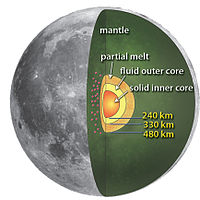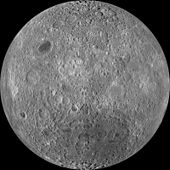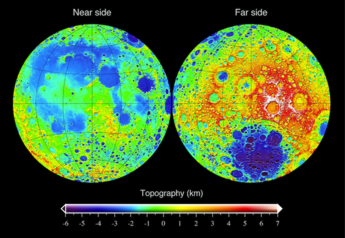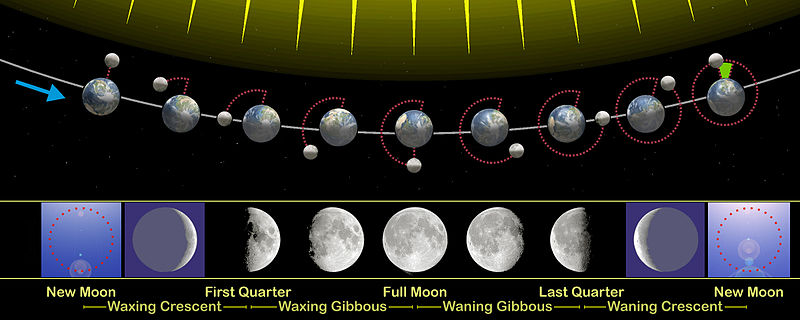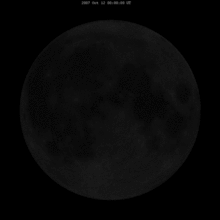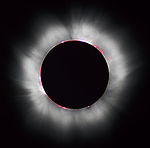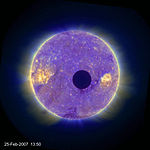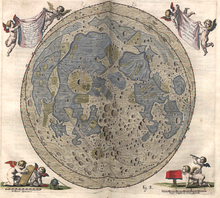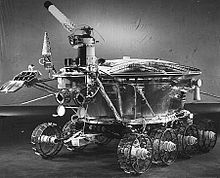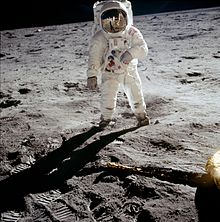- Moon
-
This article is about Earth's Moon. For moons in general, see Natural satellite. For other uses, see Moon (disambiguation).
The Moon 
 Designations
DesignationsAdjective lunar, selenic Perigee 362,570 km (0.0024 AU)
(356,400–370,400 km)Apogee 405,410 km (0.0027 AU)
(404,000–406,700 km)Semi-major axis 384,399 km (0.00257 AU)[1] Eccentricity 0.0549[1] Orbital period 27.321582 d (27 d 7 h 43.1 min[1]) Synodic period 29.530589 d (29 d 12 h 44 min 2.9 s) Average orbital speed 1.022 km/s Inclination 5.145° to the ecliptic[1]
(between 18.29° and 28.58° to Earth's equator)Longitude of ascending node regressing by one revolution in 18.6 years Argument of perigee progressing by one revolution in 8.85 years Satellite of Earth Physical characteristicsMean radius 1,737.10 km (0.273 Earths)[1][2] Equatorial radius 1,738.14 km (0.273 Earths)[2] Polar radius 1,735.97 km (0.273 Earths)[2] Flattening 0.00125 Circumference 10,921 km (equatorial) Surface area 3.793 × 107 km2 (0.074 Earths) Volume 2.1958 × 1010 km3 (0.020 Earths) Mass 7.3477 × 1022 kg (0.0123 Earths[1]) Mean density 3.3464 g/cm3[1] Equatorial surface gravity 1.622 m/s2 (0.165 4 g) Escape velocity 2.38 km/s Sidereal rotation
period27.321582 d (synchronous) Equatorial rotation velocity 4.627 m/s Axial tilt 1.5424° (to ecliptic)
6.687° (to orbit plane)Albedo 0.136[3] Surface temp.
equator
85°N[4]min mean max 100 K 220 K 390 K 70 K 130 K 230 K Apparent magnitude −2.5 to −12.9[nb 1]
−12.74 (mean full Moon)[2]Angular diameter 29.3 to 34.1 arcminutes[2][nb 2] Surface pressure 10−7 Pa (day)
10−10 Pa (night)Composition Ar, He, Na, K, H, Rn The Moon is Earth's only known natural satellite,[nb 4][6] and the fifth largest satellite in the Solar System. It is the largest natural satellite of a planet in the Solar System relative to the size of its primary, having a quarter the diameter of Earth and 1⁄81 its mass.[nb 5] The Moon is the second densest satellite after Io, a satellite of Jupiter. It is in synchronous rotation with Earth, always showing the same face; the near side is marked with dark volcanic maria among the bright ancient crustal highlands and prominent impact craters. It is the brightest object in the sky after the Sun, although its surface is actually very dark, with a similar reflectance to coal. Its prominence in the sky and its regular cycle of phases have since ancient times made the Moon an important cultural influence on language, calendars, art and mythology. The Moon's gravitational influence produces the ocean tides and the minute lengthening of the day. The Moon's current orbital distance, about thirty times the diameter of the Earth, causes it to appear almost the same size in the sky as the Sun, allowing it to cover the Sun nearly precisely in total solar eclipses.
The Moon is the only celestial body on which humans have landed. While the Soviet Union's Luna programme was the first to reach the Moon with unmanned spacecraft in 1959, the United States' NASA Apollo program achieved the only manned missions to date, beginning with the first manned lunar orbiting mission by Apollo 8 in 1968, and six manned lunar landings between 1969 and 1972—the first being Apollo 11. These missions returned over 380 kg of lunar rocks, which have been used to develop a detailed geological understanding of the Moon's origins (it is thought to have formed some 4.5 billion years ago in a giant impact event involving Earth), the formation of its internal structure, and its subsequent history.
After the Apollo 17 mission in 1972, the Moon has been visited only by unmanned spacecraft, notably by the final Soviet Lunokhod rover. Since 2004, Japan, China, India, the United States, and the European Space Agency have each sent lunar orbiters. These spacecraft have contributed to confirming the discovery of lunar water ice in permanently shadowed craters at the poles and bound into the lunar regolith. Future manned missions to the Moon have been planned, including government as well as privately funded efforts. The Moon remains, under the Outer Space Treaty, free to all nations to explore for peaceful purposes.
Contents
Name and etymology
The English proper name for Earth's natural satellite is "the Moon".[7][8] The noun moon derives from moone (around 1380), which developed from mone (1135), which derives from Old English mōna (dating from before 725), which, like all Germanic language cognates, ultimately stems from Proto-Germanic *mǣnōn.[9]
The principal modern English adjective pertaining to the Moon is lunar, derived from the Latin Luna. Another less common adjective is selenic, derived from the Ancient Greek Selene (Σελήνη), from which the prefix "seleno-" (as in selenography) is derived.[10]
Formation
Several mechanisms have been proposed for the Moon's formation 4.527 ± 0.010 billion years ago,[nb 6] some 30–50 million years after the origin of the Solar System.[11] These include the fission of the Moon from the Earth's crust through centrifugal forces,[12] which would require too great an initial spin of the Earth,[13] the gravitational capture of a pre-formed Moon,[14] which would require an unfeasibly extended atmosphere of the Earth to dissipate the energy of the passing Moon,[13] and the co-formation of the Earth and the Moon together in the primordial accretion disk, which does not explain the depletion of metallic iron in the Moon.[13] These hypotheses also cannot account for the high angular momentum of the Earth–Moon system.[15]
The prevailing hypothesis today is that the Earth–Moon system formed as a result of a giant impact: a Mars-sized body hit the nearly formed proto-Earth, blasting material into orbit around the proto-Earth, which accreted to form the Moon.[16] Giant impacts are thought to have been common in the early Solar System. Computer simulations modelling a giant impact are consistent with measurements of the angular momentum of the Earth–Moon system, and the small size of the lunar core; they also show that most of the Moon came from the impactor, not from the proto-Earth.[17] However, meteorites show that other inner Solar System bodies such as Mars and Vesta have very different oxygen and tungsten isotopic compositions to the Earth, while the Earth and Moon have near-identical isotopic compositions. Post-impact mixing of the vaporized material between the forming Earth and Moon could have equalized their isotopic compositions,[18] although this is debated.[19]
The large amount of energy released in the giant impact event and the subsequent reaccretion of material in Earth orbit would have melted the outer shell of the Earth, forming a magma ocean.[20][21] The newly formed Moon would also have had its own lunar magma ocean; estimates for its depth range from about 500 km to the entire radius of the Moon.[20]
Physical characteristics
Internal structure
Chemical composition of the lunar surface regolith (derived from crustal rocks)[22] Compound Formula Composition (wt %) Maria Highlands silica SiO2 45.4% 45.5% alumina Al2O3 14.9% 24.0% lime CaO 11.8% 15.9% iron(II) oxide FeO 14.1% 5.9% magnesia MgO 9.2% 7.5% titanium dioxide TiO2 3.9% 0.6% sodium oxide Na2O 0.6% 0.6% Total 99.9% 100.0% The Moon is a differentiated body: it has a geochemically distinct crust, mantle, and core. The Moon has a solid iron-rich inner core with a radius of 240 kilometers and a fluid outer core primarily made of liquid iron with a radius of roughly 300 kilometers. Around the core is a partially molten boundary layer with a radius of about 500 kilometers.[23] This structure is thought to have developed through the fractional crystallization of a global magma ocean shortly after the Moon's formation 4.5 billion years ago.[24] Crystallization of this magma ocean would have created a mafic mantle from the precipitation and sinking of the minerals olivine, clinopyroxene, and orthopyroxene; after about three-quarters of the magma ocean had crystallised, lower-density plagioclase minerals could form and float into a crust on top.[25] The final liquids to crystallise would have been initially sandwiched between the crust and mantle, with a high abundance of incompatible and heat-producing elements.[1] Consistent with this, geochemical mapping from orbit shows the crust is mostly anorthosite,[5] and moon rock samples of the flood lavas erupted on the surface from partial melting in the mantle confirm the mafic mantle composition, which is more iron rich than that of Earth.[1] Geophysical techniques suggest that the crust is on average ~50 km thick.[1]
The Moon is the second densest satellite in the Solar System after Io.[26] However, the inner core of the Moon is small, with a radius of about 350 km or less;[1] this is only ~20% the size of the Moon, in contrast to the ~50% of most other terrestrial bodies. Its composition is not well constrained, but it is probably metallic iron alloyed with a small amount of sulphur and nickel; analyses of the Moon's time-variable rotation indicate that it is at least partly molten.[27]
Surface geology
The topography of the Moon has been measured with laser altimetry and stereo image analysis.[29] The most visible topographic feature is the giant far side South Pole – Aitken basin, some 2,240 km in diameter, the largest crater on the Moon and the largest known crater in the Solar System.[30][31] At 13 km deep, its floor is the lowest elevation on the Moon.[30][32] The highest elevations are found just to its north-east, and it has been suggested that this area might have been thickened by the oblique formation impact of South Pole – Aitken.[33] Other large impact basins, such as Imbrium, Serenitatis, Crisium, Smythii, and Orientale, also possess regionally low elevations and elevated rims.[30] The lunar far side is on average about 1.9 km higher than the near side.[1]
Volcanic features
The dark and relatively featureless lunar plains which can clearly be seen with the naked eye are called maria (Latin for "seas"; singular mare), since they were believed by ancient astronomers to be filled with water.[34] They are now known to be vast solidified pools of ancient basaltic lava. While similar to terrestrial basalts, the mare basalts have much higher abundances of iron and are completely lacking in minerals altered by water.[35][36] The majority of these lavas erupted or flowed into the depressions associated with impact basins. Several geologic provinces containing shield volcanoes and volcanic domes are found within the near side maria.[37]
Maria are found almost exclusively on the near side of the Moon, covering 31% of the surface on the near side,[38] compared with a few scattered patches on the far side covering only 2%.[39] This is thought to be due to a concentration of heat-producing elements under the crust on the near side, seen on geochemical maps obtained by Lunar Prospector's gamma-ray spectrometer, which would have caused the underlying mantle to heat up, partially melt, rise to the surface and erupt.[25][40][41] Most of the Moon's mare basalts erupted during the Imbrian period, 3.0–3.5 billion years ago, although some radiometrically dated samples are as old as 4.2 billion years,[42] and the youngest eruptions, dated by crater counting, appear to have been only 1.2 billion years ago.[43]
The lighter-coloured regions of the Moon are called terrae, or more commonly highlands, since they are higher than most maria. They have been radiometrically dated as forming 4.4 billion years ago, and may represent plagioclase cumulates of the lunar magma ocean.[42][43] In contrast to the Earth, no major lunar mountains are believed to have formed as a result of tectonic events.[44]
Impact craters
The other major geologic process that has affected the Moon's surface is impact cratering,[45] with craters formed when asteroids and comets collide with the lunar surface. There are estimated to be roughly 300,000 craters wider than 1 km on the Moon's near side alone.[46] Some of these are named for scholars, scientists, artists and explorers.[47] The lunar geologic timescale is based on the most prominent impact events, including Nectaris, Imbrium, and Orientale, structures characterized by multiple rings of uplifted material, typically hundreds to thousands of kilometres in diameter and associated with a broad apron of ejecta deposits that form a regional stratigraphic horizon.[48] The lack of an atmosphere, weather and recent geological processes mean that many of these craters are well-preserved. While only a few multi-ring basins have been definitively dated, they are useful for assigning relative ages. Since impact craters accumulate at a nearly constant rate, counting the number of craters per unit area can be used to estimate the age of the surface.[48] The radiometric ages of impact-melted rocks collected during the Apollo missions cluster between 3.8 and 4.1 billion years old: this has been used to propose a Late Heavy Bombardment of impacts.[49]
Blanketed on top of the Moon's crust is a highly comminuted (broken into ever smaller particles) and impact gardened surface layer called regolith, formed by impact processes. The finer regolith, the lunar soil of silicon dioxide glass, has a texture like snow and smell like spent gunpowder.[50] The regolith of older surfaces is generally thicker than for younger surfaces: it varies in thickness from 10–20 m in the highlands and 3–5 m in the maria.[51] Beneath the finely comminuted regolith layer is the megaregolith, a layer of highly fractured bedrock many kilometres thick.[52]
Presence of water
Liquid water cannot persist on the lunar surface. When exposed to solar radiation, water quickly decomposes through a process known as photodissociation and is lost to space. However since the 1960s, scientists have hypothesized that water ice may be deposited by impacting comets or possibly produced by the reaction of oxygen-rich lunar rocks, and hydrogen from solar wind, leaving traces of water which could possibly survive in cold, permanently shadowed craters at either pole on the Moon.[53][54] Computer simulations suggest that up to 14,000 km2 of the surface may be in permanent shadow.[55] The presence of usable quantities of water on the Moon is an important factor in rendering lunar habitation as a cost-effective plan; the alternative of transporting water from Earth would be prohibitively expensive.[56]
In years since, signatures of water have been found to exist on the lunar surface.[57] In 1994, the bistatic radar experiment located on the Clementine spacecraft, indicated the existence of small, frozen pockets of water close to the surface. However, later radar observations by Arecibo, suggest these findings may rather be rocks ejected from young impact craters.[58] In 1998, the neutron spectrometer located on the Lunar Prospector spacecraft, indicated that high concentrations of hydrogen are present in the first meter of depth in the regolith near the polar regions.[59] In 2008, an analysis of volcanic lava beads, brought back to Earth aboard Apollo 15, showed small amounts of water to exist in the interior of the beads.[60]
The 2008, Chandrayaan-1 spacecraft has since confirmed the existence of surface water ice, using the on-board Moon Mineralogy Mapper. The spectrometer observed absorption lines common to hydroxyl, in reflected sunlight, providing evidence of large quantities of water ice, on the lunar surface. The spacecraft showed that concentrations may possibly be as high as 1,000 ppm.[61] In 2009, LCROSS sent a 2300 kg impactor into a permanently shadowed polar crater, and detected at least 100 kg of water in a plume of ejected material.[62][63] Another examination of the LCROSS data showed the amount of detected water, to be closer to 155 kilograms (± 12 kg).[64]
In May 2011, Erik Hauri et al. reported[65] 615–1410 ppm water in melt inclusions in lunar sample 74220, the famous high-titanium "orange glass soil" of volcanic origin collected during the Apollo 17 mission in 1972. The inclusions were formed during explosive eruptions on the moon approximately 3.7 billion years ago.
This concentration is comparable with that of magma in Earth's upper mantle. While of considerable selenological interest, this announcement affords little comfort to would-be lunar colonists. The sample originated many kilometers below the surface, and the inclusions are so difficult to access that it took 39 years to find them with a state-of-the-art ion microprobe instrument.
Gravity and magnetic fields
The gravitational field of the Moon has been measured through tracking the Doppler shift of radio signals emitted by orbiting spacecraft. The main lunar gravity features are mascons, large positive gravitational anomalies associated with some of the giant impact basins, partly caused by the dense mare basaltic lava flows that fill these basins.[66] These anomalies greatly influence the orbit of spacecraft about the Moon. There are some puzzles: lava flows by themselves cannot explain all of the gravitational signature, and some mascons exist that are not linked to mare volcanism.[67]
The Moon has an external magnetic field of the order of one to a hundred nanoteslas, less than one-hundredth that of the Earth. It does not currently have a global dipolar magnetic field, as would be generated by a liquid metal core geodynamo, and only has crustal magnetization, probably acquired early in lunar history when a geodynamo was still operating.[68][69] Alternatively, some of the remnant magnetization may be from transient magnetic fields generated during large impact events, through the expansion of an impact-generated plasma cloud in the presence of an ambient magnetic field—this is supported by the apparent location of the largest crustal magnetizations near the antipodes of the giant impact basins.[70]
Atmosphere
The Moon has an atmosphere so tenuous as to be nearly vacuum, with a total mass of less than 10 metric tons.[71] The surface pressure of this small mass is around 3 × 10−15 atm (0.3 nPa); it varies with the lunar day. Its sources include outgassing and sputtering, the release of atoms from the bombardment of lunar soil by solar wind ions.[5][72] Elements that have been detected include sodium and potassium, produced by sputtering, which are also found in the atmospheres of Mercury and Io; helium-4 from the solar wind; and argon-40, radon-222, and polonium-210, outgassed after their creation by radioactive decay within the crust and mantle.[73][74] The absence of such neutral species (atoms or molecules) as oxygen, nitrogen, carbon, hydrogen and magnesium, which are present in the regolith, is not understood.[73] Water vapour has been detected by Chandrayaan-1 and found to vary with latitude, with a maximum at ~60–70 degrees; it is possibly generated from the sublimation of water ice in the regolith.[75] These gases can either return into the regolith due to the Moon's gravity, or be lost to space: either through solar radiation pressure, or if they are ionised, by being swept away by the solar wind's magnetic field.[73]
Seasons
The Moon's axial tilt is only 1.54°, much less than the 23.44° of the Earth. Because of this, the Moon's solar illumination varies much less with season, and topographical details play a crucial role in seasonal effects.[76] From images taken by Clementine in 1994, it appears that four mountainous regions on the rim of Peary crater at the Moon's north pole remain illuminated for the entire lunar day, creating peaks of eternal light. No such regions exist at the south pole. Similarly, there are places that remain in permanent shadow at the bottoms of many polar craters,[55] and these dark craters are extremely cold: Lunar Reconnaissance Orbiter measured the lowest summer temperatures in craters at the southern pole at 35 K (−238 °C),[77] and just 26 K close to the winter solstice in north polar Hermite Crater. This is the coldest temperature in the Solar System ever measured by a spacecraft, colder even than the surface of Pluto.[76]
Relationship to Earth
Orbit
The Moon makes a complete orbit around the Earth with respect to the fixed stars about once every 27.3 days[nb 7] (its sidereal period). However, since the Earth is moving in its orbit about the Sun at the same time, it takes slightly longer for the Moon to show the same phase to Earth, which is about 29.5 days[nb 8] (its synodic period).[38] Unlike most satellites of other planets, the Moon orbits nearer the ecliptic plane than to the planet's equatorial plane. The Moon's orbit is subtly perturbed by the Sun and Earth in many small, complex and interacting ways. For example, the plane of the Moon's orbital motion gradually rotates, which affects other aspects of lunar motion. These follow-on effects are mathematically described by Cassini's laws.[78]
Relative size
The Moon is exceptionally large relative to the Earth: a quarter the diameter of the planet and 1/81 its mass.[38] It is the second largest moon orbiting an object in the solar system relative to the size of its planet. Charon is larger relative to the dwarf planet Pluto, at slightly more than 1/9 (11.6%) of Pluto's mass.[80]
However, the Earth and Moon are still considered a planet–satellite system, rather than a double-planet system, as their barycentre, the common centre of mass, is located 1,700 km (about a quarter of the Earth's radius) beneath the surface of the Earth.[81]
Appearance from Earth
The Moon is in synchronous rotation: it rotates about its axis in about the same time it takes to orbit the Earth. This results in it nearly always keeping the same face turned towards the Earth. The Moon used to rotate at a faster rate, but early in its history, its rotation slowed and became tidally locked in this orientation as a result of frictional effects associated with tidal deformations caused by the Earth.[82] The side of the Moon that faces Earth is called the near side, and the opposite side the far side. The far side is often called the "dark side," but in fact, it is illuminated as often as the near side: once per lunar day, during the new Moon phase we observe on Earth when the near side is dark.[83]
The Moon has an exceptionally low albedo, giving it a similar reflectance to coal. Despite this, it is the second brightest object in the sky after the Sun.[38][nb 9] This is partly due to the brightness enhancement of the opposition effect; at quarter phase, the Moon is only one-tenth as bright, rather than half as bright, as at full Moon.[84] Additionally, colour constancy in the visual system recalibrates the relations between the colours of an object and its surroundings, and since the surrounding sky is comparatively dark, the sunlit Moon is perceived as a bright object. The edges of the full Moon seem as bright as the centre, with no limb darkening, due to the reflective properties of lunar soil, which reflects more light back towards the Sun than in other directions. The Moon does appear larger when close to the horizon, but this is a purely psychological effect, known as the Moon illusion, first described in the 7th century BC.[85] The full Moon subtends an arc of about 0.52° (on average) in the sky, roughly the same apparent size as the Sun (see eclipses).
The highest altitude of the Moon in the sky varies: while it has nearly the same limit as the Sun, it alters with the lunar phase and with the season of the year, with the full Moon highest during winter. The 18.6-year nodes cycle also has an influence: when the ascending node of the lunar orbit is in the vernal equinox, the lunar declination can go as far as 28° each month. This means the Moon can go overhead at latitudes up to 28° from the equator, instead of only 18°. The orientation of the Moon's crescent also depends on the latitude of the observation site: close to the equator, an observer can see a smile-shaped crescent Moon.[86]
The distance between the moon and the Earth varies from around 356,400 km to 406,700 km at the extreme perigees (closest) and apogees (farthest). On 19 March 2011, it was closer to the earth while at full phase than it has been since 1993.[87] Reported as a "super moon", this closest point coincides within an hour of a full moon, and it thus appeared 30 percent brighter, and 14 percent larger than when at its greatest distance.[88][89][90]
There has been historical controversy over whether features on the Moon's surface change over time. Today, many of these claims are thought to be illusory, resulting from observation under different lighting conditions, poor astronomical seeing, or inadequate drawings. However, outgassing does occasionally occur, and could be responsible for a minor percentage of the reported lunar transient phenomena. Recently, it has been suggested that a roughly 3 km diameter region of the lunar surface was modified by a gas release event about a million years ago.[91][92] The Moon's appearance, like that of the Sun, can be affected by Earth's atmosphere: common effects are a 22° halo ring formed when the Moon's light is refracted through the ice crystals of high cirrostratus cloud, and smaller coronal rings when the Moon is seen through thin clouds.[93]
Tidal effects
The tides on the Earth are mostly generated by the gradient in intensity of the Moon's gravitational pull from one side of the Earth to the other, the tidal forces. This forms two tidal bulges on the Earth, which are most clearly seen in elevated sea level as ocean tides.[94] Since the Earth spins about 27 times faster than the Moon moves around it, the bulges are dragged along with the Earth's surface faster than the Moon moves, rotating around the Earth once a day as it spins on its axis.[94] The ocean tides are magnified by other effects: frictional coupling of water to Earth's rotation through the ocean floors, the inertia of water's movement, ocean basins that get shallower near land, and oscillations between different ocean basins.[95] The gravitational attraction of the Sun on the Earth's oceans is almost half that of the Moon, and their gravitational interplay is responsible for spring and neap tides.[94]
Gravitational coupling between the Moon and the bulge nearest the Moon acts as a torque on the Earth's rotation, draining angular momentum and rotational kinetic energy from the Earth's spin.[94][96] In turn, angular momentum is added to the Moon's orbit, accelerating it, which lifts the Moon into a higher orbit with a longer period. As a result, the distance between the Earth and Moon is increasing, and the Earth's spin slowing down.[96] Measurements from lunar ranging experiments with laser reflectors left during the Apollo missions have found that the Moon's distance to the Earth increases by 38 mm per year[97] (though this is only 0.10 ppb/year of the radius of the Moon's orbit). Atomic clocks also show that the Earth's day lengthens by about 15 microseconds every year,[98] slowly increasing the rate at which UTC is adjusted by leap seconds. Left to run its course, this tidal drag would continue until the spin of the Earth and the orbital period of the Moon matched. However, the Sun will become a red giant long before that, engulfing the Earth.[99][100]
The lunar surface also experiences tides of amplitude ~10 cm over 27 days, with two components: a fixed one due to the Earth, as they are in synchronous rotation, and a varying component from the Sun.[96] The Earth-induced component arises from libration, a result of the Moon's orbital eccentricity; if the Moon's orbit were perfectly circular, there would only be solar tides.[96] Libration also changes the angle from which the Moon is seen, allowing about 59% of its surface to be seen from the Earth (but only half at any instant).[38] The cumulative effects of stress built up by these tidal forces produces moonquakes. Moonquakes are much less common and weaker than earthquakes, although they can last for up to an hour – a significantly longer time than terrestrial earthquakes – because of the absence of water to damp out the seismic vibrations. The existence of moonquakes was an unexpected discovery from seismometers placed on the Moon by Apollo astronauts from 1969 through 1972.[101]
Eclipses
Eclipses can only occur when the Sun, Earth, and Moon are all in a straight line (termed "syzygy"). Solar eclipses occur near a new Moon, when the Moon is between the Sun and Earth. In contrast, lunar eclipses occur near a full Moon, when the Earth is between the Sun and Moon. The apparent size of the Moon is roughly the same as that of the Sun, with both being viewed at close to one-half a degree wide. The Sun is much larger than the Moon but it is the precise vastly greater distance that coincidentally gives it the same apparent size as the much closer and much smaller Moon from the perspective of the Earth. The variations in apparent size, due to the non-circular orbits, are nearly the same as well, though occurring in different cycles. This makes possible both total (with the Moon appearing larger than the Sun) and annular (with the Moon appearing smaller than the Sun) solar eclipses.[103] In a total eclipse, the Moon completely covers the disc of the Sun and the solar corona becomes visible to the naked eye. Since the distance between the Moon and the Earth is very slowly increasing over time,[94] the angular diameter of the Moon is decreasing. This means that hundreds of millions of years ago the Moon would always completely cover the Sun on solar eclipses, and no annular eclipses were possible. Likewise, about 600 million years from now (if the angular diameter of the Sun does not change), the Moon will no longer cover the Sun completely, and only annular eclipses will occur.[104]
Because the Moon's orbit around the Earth is inclined by about 5° to the orbit of the Earth around the Sun, eclipses do not occur at every full and new Moon. For an eclipse to occur, the Moon must be near the intersection of the two orbital planes.[104] The periodicity and recurrence of eclipses of the Sun by the Moon, and of the Moon by the Earth, is described by the saros cycle, which has a period of approximately 18 years.[105]
As the Moon is continuously blocking our view of a half-degree-wide circular area of the sky,[nb 10][106] the related phenomenon of occultation occurs when a bright star or planet passes behind the Moon and is occulted: hidden from view. In this way, a solar eclipse is an occultation of the Sun. Because the Moon is comparatively close to the Earth, occultations of individual stars are not visible everywhere on the planet, nor at the same time. Because of the precession of the lunar orbit, each year different stars are occulted.[107]
Study and exploration
See also: Robotic exploration of the Moon, List of current and future lunar missions, Colonization of the Moon, and List of man-made objects on the MoonMap of the Moon by Johannes Hevelius from his Selenographia (1647), the first map to include the libration zones.
Early studies
Understanding of the Moon's cycles was an early development of astronomy: by the 5th century BC, Babylonian astronomers had recorded the 18-year Saros cycle of lunar eclipses,[108] and Indian astronomers had described the Moon’s monthly elongation.[109] The Chinese astronomer Shi Shen (fl. 4th century BC) gave instructions for predicting solar and lunar eclipses.[110] Later, the physical form of the Moon and the cause of moonlight became understood. The ancient Greek philosopher Anaxagoras (d. 428 BC) reasoned that the Sun and Moon were both giant spherical rocks, and that the latter reflected the light of the former.[111][112] Although the Chinese of the Han Dynasty believed the Moon to be energy equated to qi, their 'radiating influence' theory also recognized that the light of the Moon was merely a reflection of the Sun, and Jing Fang (78–37 BC) noted the sphericity of the Moon.[113] In 499 AD, the Indian astronomer Aryabhata mentioned in his Aryabhatiya that reflected sunlight is the cause of the shining of the Moon.[114] The astronomer and physicist Alhazen (965–1039) found that sunlight was not reflected from the Moon like a mirror, but that light was emitted from every part of the Moon's sunlit surface in all directions.[115] Shen Kuo (1031–1095) of the Song Dynasty created an allegory equating the waxing and waning of the Moon to a round ball of reflective silver that, when doused with white powder and viewed from the side, would appear to be a crescent.[116]
In Aristotle's (384–322 BC) description of the universe, the Moon marked the boundary between the spheres of the mutable elements (earth, water, air and fire), and the imperishable stars of aether, an influential philosophy that would dominate for centuries.[117] However, in the 2nd century BC, Seleucus of Seleucia correctly theorized that tides were due to the attraction of the Moon, and that their height depends on the Moon's position relative to the Sun.[118] In the same century, Aristarchus computed the size and distance of the Moon from Earth, obtaining a value of about twenty times the Earth radius for the distance. These figures were greatly improved by Ptolemy (90–168 AD): his values of a mean distance of 59 times the Earth's radius and a diameter of 0.292 Earth diameters were close to the correct values of about 60 and 0.273 respectively.[119] Archimedes (287–212 BC) invented a planetarium calculating motions of the Moon and the known planets.[120]
During the Middle Ages, before the invention of the telescope, the Moon was increasingly recognised as a sphere, though many believed that it was "perfectly smooth".[121] In 1609, Galileo Galilei drew one of the first telescopic drawings of the Moon in his book Sidereus Nuncius and noted that it was not smooth but had mountains and craters. Telescopic mapping of the Moon followed: later in the 17th century, the efforts of Giovanni Battista Riccioli and Francesco Maria Grimaldi led to the system of naming of lunar features in use today. The more exact 1834-6 Mappa Selenographica of Wilhelm Beer and Johann Heinrich Mädler, and their associated 1837 book Der Mond, the first trigonometrically accurate study of lunar features, included the heights of more than a thousand mountains, and introduced the study of the Moon at accuracies possible in earthly geography.[122] Lunar craters, first noted by Galileo, were thought to be volcanic until the 1870s proposal of Richard Proctor that they were formed by collisions.[38] This view gained support in 1892 from the experimentation of geologist Grove Karl Gilbert, and from comparative studies from 1920 to the 1940s,[123] leading to the development of lunar stratigraphy, which by the 1950s was becoming a new and growing branch of astrogeology.[38]
First direct exploration: 1959–1976
Soviet missions
The Cold War-inspired Space Race between the Soviet Union and the U.S. led to an acceleration of interest in exploration of the Moon. Once launchers had the necessary capabilities, these nations sent unmanned probes on both flyby and impact/lander missions. Spacecraft from the Soviet Union's Luna program were the first to accomplish a number of goals: following three unnamed, failed missions in 1958,[124] the first man-made object to escape Earth's gravity and pass near the Moon was Luna 1; the first man-made object to impact the lunar surface was Luna 2, and the first photographs of the normally occluded far side of the Moon were made by Luna 3, all in 1959.
The first spacecraft to perform a successful lunar soft landing was Luna 9 and the first unmanned vehicle to orbit the Moon was Luna 10, both in 1966.[38] Rock and soil samples were brought back to Earth by three Luna sample return missions (Luna 16 in 1970, Luna 20 in 1972, and Luna 24 in 1976), which returned 0.3 kg total.[125] Two pioneering robotic rovers landed on the Moon in 1970 and 1973 as a part of Soviet Lunokhod programme.
United States missions
 Earth as viewed from Lunar orbit during the Apollo 8 mission, Christmas Eve, 1968. Africa is at the sunset terminator, both Americas are under cloud, and Antarctica is at the left end of the terminator.
Earth as viewed from Lunar orbit during the Apollo 8 mission, Christmas Eve, 1968. Africa is at the sunset terminator, both Americas are under cloud, and Antarctica is at the left end of the terminator.
American lunar exploration began with robotic missions aimed at developing understanding of the lunar surface for an eventual manned landing: the Jet Propulsion Laboratory's Surveyor program landed its first spacecraft four months after Luna 9. NASA's manned Apollo program was developed in parallel; after a series of unmanned and manned tests of the Apollo spacecraft in Earth orbit, and spurred on by a potential Soviet lunar flight, in 1968 Apollo 8 made the first crewed mission to lunar orbit. The subsequent landing of the first humans on the Moon in 1969 is seen by many as the culmination of the Space Race.[126] Neil Armstrong became the first person to walk on the Moon as the commander of the American mission Apollo 11 by first setting foot on the Moon at 02:56 UTC on 21 July 1969.[127] The Apollo missions 11 to 17 (except Apollo 13, which aborted its planned lunar landing) returned 382 kg of lunar rock and soil in 2,196 separate samples.[128] The American Moon landing and return was enabled by considerable technological advances in the early 1960s, in domains such as ablation chemistry, software engineering and atmospheric re-entry technology, and by highly competent management of the enormous technical undertaking.[129][130]
Scientific instrument packages were installed on the lunar surface during all the Apollo missions. Long-lived instrument stations, including heat flow probes, seismometers, and magnetometers, were installed at the Apollo 12, 14, 15, 16, and 17 landing sites. Direct transmission of data to Earth concluded in late 1977 due to budgetary considerations,[131][132] but as the stations' lunar laser ranging corner-cube retroreflector arrays are passive instruments, they are still being used. Ranging to the stations is routinely performed from earth-based stations with an accuracy of a few centimetres, and data from this experiment are being used to place constraints on the size of the lunar core.[133]
Current era: 1990–present
Post-Apollo and Luna, many more countries have become involved in direct exploration of the Moon. In 1990, Japan became the third country to place a spacecraft into lunar orbit with its Hiten spacecraft. The spacecraft released a smaller probe, Hagoromo, in lunar orbit, but the transmitter failed, preventing further scientific use of the mission.[134] In 1994, the U.S. sent the joint Defense Department/NASA spacecraft Clementine to lunar orbit. This mission obtained the first near-global topographic map of the Moon, and the first global multispectral images of the lunar surface.[135] This was followed in 1998 by the Lunar Prospector mission, whose instruments indicated the presence of excess hydrogen at the lunar poles, which is likely to have been caused by the presence of water ice in the upper few meters of the regolith within permanently shadowed craters.[136]
The European spacecraft SMART-1, the second ion-propelled spacecraft, was in lunar orbit from 15 November 2004 until its lunar impact on 3 September 2006, and made the first detailed survey of chemical elements on the lunar surface.[137] China has expressed ambitious plans for exploring the Moon, and successfully orbited its first spacecraft, Chang'e-1, from 5 November 2007 until its controlled lunar impact on 1 March 2008.[138] In its sixteen-month mission, it obtained a full image map of the Moon. Between 4 October 2007 and 10 June 2009, the Japan Aerospace Exploration Agency's Kaguya (Selene) mission, a lunar orbiter fitted with a high-definition video camera, and two small radio-transmitter satellites, obtained lunar geophysics data and took the first high-definition movies from beyond Earth orbit.[139][140] India's first lunar mission, Chandrayaan I, orbited from 8 November 2008 until loss of contact on 27 August 2009, creating a high resolution chemical, mineralogical and photo-geological map of the lunar surface, and confirming the presence of water molecules in lunar soil.[141] The Indian Space Research Organisation plans to launch Chandrayaan II in 2013, which is slated to include a Russian robotic lunar rover.[142][143] The U.S. co-launched the Lunar Reconnaissance Orbiter (LRO) and the LCROSS impactor and follow-up observation orbiter on 18 June 2009; LCROSS completed its mission by making a planned and widely observed impact in the crater Cabeus on 9 October 2009,[144] while LRO is currently in operation, obtaining precise lunar altimetry and high-resolution imagery.
Other upcoming lunar missions include Russia's Luna-Glob: an unmanned lander, set of seismometers, and an orbiter based on its Martian Phobos-Grunt mission, which is slated to launch in 2012.[145][146] Privately funded lunar exploration has been promoted by the Google Lunar X Prize, announced 13 September 2007, which offers US$20 million to anyone who can land a robotic rover on the Moon and meet other specified criteria.[147]
NASA began to plan to resume manned missions following the call by U.S. President George W. Bush on 14 January 2004 for a manned mission to the Moon by 2019 and the construction of a lunar base by 2024.[148] The Constellation program was funded and construction and testing begun on a manned spacecraft and launch vehicle,[149] and design studies for a lunar base.[150] However, that program has been cancelled in favour of a manned asteroid landing by 2025 and a manned Mars orbit by 2035.[151] India has also expressed its hope to send a manned mission to the Moon by 2020.[152]
Astronomy from the Moon
For many years, the Moon has been recognized as an excellent site for telescopes.[153] It is relatively nearby; astronomical seeing is not a concern; certain craters near the poles are permanently dark and cold, and thus especially useful for infrared telescopes; and radio telescopes on the far side would be shielded from the radio chatter of Earth.[154] The lunar soil, although it poses a problem for any moving parts of telescopes, can be mixed with carbon nanotubes and epoxies in the construction of mirrors up to 50 meters in diameter.[155] A lunar zenith telescope can be made cheaply with ionic liquid.[156]
Legal status
Although Luna landers scattered pennants of the Soviet Union on the Moon, and U.S. flags were symbolically planted at their landing sites by the Apollo astronauts, no nation currently claims ownership of any part of the Moon's surface.[157] Russia and the U.S. are party to the 1967 Outer Space Treaty,[158] which defines the Moon and all outer space as the "province of all mankind".[157] This treaty also restricts the use of the Moon to peaceful purposes, explicitly banning military installations and weapons of mass destruction.[159] The 1979 Moon Agreement was created to restrict the exploitation of the Moon's resources by any single nation, but it has not been signed by any of the space-faring nations.[160] While several individuals have made claims to the Moon in whole or in part, none of these are considered credible.[161][162][163]
In culture
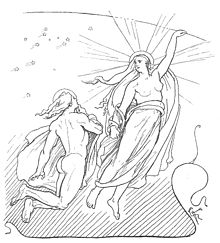 The gods Máni (left) and Sól (right), the personified Moon and Sun in Norse mythology, as depicted in an illustration by Lorenz Frølich (1895)
The gods Máni (left) and Sól (right), the personified Moon and Sun in Norse mythology, as depicted in an illustration by Lorenz Frølich (1895)
The Moon's regular phases make it a very convenient timepiece, and the periods of its waxing and waning form the basis of many of the oldest calendars. Tally sticks, notched bones dating as far back as 20–30,000 years ago, are believed by some to mark the phases of the Moon.[164][165][166] The ~30-day month is an approximation of the lunar cycle. The English noun month and its cognates in other Germanic languages stem from Proto-Germanic *mǣnṓth-, which is connected to the above mentioned Proto-Germanic *mǣnōn, indicating the usage of a lunar calendar among the Germanic peoples (Germanic calendar) prior to the adoption of a solar calendar.[167] The same Indo-European root as moon led, via Latin, to measure and menstrual, words which echo the Moon's importance to many ancient cultures in measuring time (see Latin mensis and Ancient Greek μήνας (mēnas), meaning "month").[168][169]
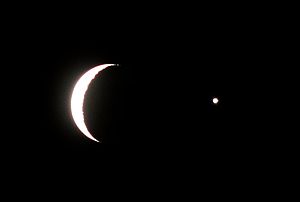 A crescent Moon and a star are a common symbol of Islam, appearing in numerous flags including those of Turkey and Pakistan.
A crescent Moon and a star are a common symbol of Islam, appearing in numerous flags including those of Turkey and Pakistan.
The Moon has been the subject of many works of art and literature and the inspiration for countless others. It is a motif in the visual arts, the performing arts, poetry, prose and music. A 5,000-year-old rock carving at Knowth, Ireland, may represent the Moon, which would be the earliest depiction discovered.[170] The contrast between the brighter highlands and darker maria create the patterns seen by different cultures as the Man in the Moon, the rabbit and the buffalo, among others. In many prehistoric and ancient cultures, the Moon was personified as a deity or other supernatural phenomenon, and astrological views of the Moon continue to be propagated today.
The Moon has a long association with insanity and irrationality; the words lunacy and loony are derived from the Latin name for the Moon, Luna. Philosophers such as Aristotle and Pliny the Elder argued that the full Moon induced insanity in susceptible individuals, believing that the brain, which is mostly water, must be affected by the Moon and its power over the tides, but the Moon's gravity is too slight to affect any single person.[171] Even today, people insist that admissions to psychiatric hospitals, traffic accidents, homicides or suicides increase during a full Moon, although there is no scientific evidence to support such claims.[171]
See also
References
- Notes
- ^ The maximum value is given based on scaling of the brightness from the value of −12.74 given for an equator to Moon-centre distance of 378 000 km in the NASA factsheet reference to the minimum Earth-Moon distance given there, after the latter is corrected for the Earth's equatorial radius of 6 378 km, giving 350 600 km. The minimum value (for a distant new Moon) is based on a similar scaling using the maximum Earth-Moon distance of 407 000 km (given in the factsheet) and by calculating the brightness of the earthshine onto such a new Moon. The brightness of the earthshine is [ Earth albedo × (Earth radius / Radius of Moon's orbit)2 ] relative to the direct solar illumination that occurs for a full Moon. (Earth albedo = 0.367; Earth radius = (polar radius × equatorial radius)½ = 6 367 km.)
- ^ The range of angular size values given are based on simple scaling of the following values given in the fact sheet reference: at an Earth-equator to Moon-centre distance of 378 000 km, the angular size is 1896 arcseconds. The same fact sheet gives extreme Earth-Moon distances of 407 000 km and 357 000 km. For the maximum angular size, the minimum distance has to be corrected for the Earth's equatorial radius of 6 378 km, giving 350 600 km.
- ^ Lucey et al. (2006) give 107 particles cm−3 by day and 105 particles cm−3 by night. Along with equatorial surface temperatures of 390 K by day and 100 K by night, the ideal gas law yields the pressures given in the infobox (rounded to the nearest order of magnitude; 10−7 Pa by day and 10−10 Pa by night.
- ^ There are a number of near-Earth asteroids including 3753 Cruithne that are co-orbital with Earth: their orbits bring them close to Earth for periods of time but then alter in the long term (Morais et al, 2002). These are quasi-satellites and not true moons. For more information, see Other moons of Earth.
- ^ Charon is proportionally larger in comparison to Pluto, but Pluto has been reclassified as a dwarf planet
- ^ This age is calculated from isotope dating of lunar rocks.
- ^ More accurately, the Moon's mean sidereal period (fixed star to fixed star) is 27.321661 days (27d 07h 43m 11.5s), and its mean tropical orbital period (from equinox to equinox) is 27.321582 days (27d 07h 43m 04.7s) (Explanatory Supplement to the Astronomical Ephemeris, 1961, at p.107).
- ^ More accurately, the Moon's mean synodic period (between mean solar conjunctions) is 29.530589 days (29d 12h 44m 02.9s) (Explanatory Supplement to the Astronomical Ephemeris, 1961, at p.107).
- ^ The Sun's apparent magnitude is −26.7, and the full Moon's apparent magnitude is −12.7.
- ^ On average, the Moon covers an area of 0.21078 square degrees on the night sky.
- Footnotes
- ^ a b c d e f g h i j k l Wieczorek, M.; et al. (2006). "The constitution and structure of the lunar interior". Reviews in Mineralogy and Geochemistry 60 (1): 221–364. doi:10.2138/rmg.2006.60.3.
- ^ a b c d e Williams, Dr. David R. (2 February 2006). "Moon Fact Sheet". NASA (National Space Science Data Center). http://nssdc.gsfc.nasa.gov/planetary/factsheet/moonfact.html. Retrieved 31 December 2008.
- ^ Matthews, Grant (2008). "Celestial body irradiance determination from an underfilled satellite radiometer: application to albedo and thermal emission measurements of the Moon using CERES". Applied Optics 47 (27): 4981–93. Bibcode 2008ApOpt..47.4981M. doi:10.1364/AO.47.004981. PMID 18806861.
- ^ A.R. Vasavada, D.A. Paige, and S.E. Wood (1999). "Near-Surface Temperatures on Mercury and the Moon and the Stability of Polar Ice Deposits". Icarus 141 (2): 179. Bibcode 1999Icar..141..179V. doi:10.1006/icar.1999.6175.
- ^ a b c Lucey, P.; et al. (2006). "Understanding the lunar surface and space-Moon interactions". Reviews in Mineralogy and Geochemistry 60 (1): 83–219. doi:10.2138/rmg.2006.60.2.
- ^ Morais, M.H.M.; Morbidelli, A. (2002). "The Population of Near-Earth Asteroids in Coorbital Motion with the Earth". Icarus 160 (1): 1–9. Bibcode 2002Icar..160....1M. doi:10.1006/icar.2002.6937.
- ^ "Naming Astronomical Objects: Spelling of Names". International Astronomical Union. http://www.iau.org/public_press/themes/naming/#spelling. Retrieved 29 March 2010.
- ^ "Gazetteer of Planetary Nomenclature: Planetary Nomenclature FAQ". USGS Astrogeology Research Program. http://planetarynames.wr.usgs.gov/nomenFAQ.html. Retrieved 29 March 2010.
- ^ Barnhart, Robert K. (1995). The Barnhart Concise Dictionary of Etymology. USA: Harper Collins. p. 487. ISBN 0-06-270084-7.
- ^ "Oxford English Dictionary: lunar, a. and n.". Oxford English Dictionary: Second Edition 1989. Oxford University Press. http://dictionary.oed.com/cgi/entry/50136796?single=1&query_type=word&queryword=lunar&first=1&max_to_show=10. Retrieved 23 March 2010.
- ^ Kleine, T.; Palme, H.; Mezger, K.; Halliday, A.N. (2005). "Hf–W Chronometry of Lunar Metals and the Age and Early Differentiation of the Moon". Science 310 (5754): 1671–1674. Bibcode 2005Sci...310.1671K. doi:10.1126/science.1118842. PMID 16308422.
- ^ Binder, A.B. (1974). "On the origin of the Moon by rotational fission". The Moon 11 (2): 53–76. Bibcode 1974Moon...11...53B. doi:10.1007/BF01877794.
- ^ a b c Stroud, Rick (2009). The Book of the Moon. Walken and Company. pp. 24–27. ISBN 0-8027-1734-9.
- ^ Mitler, H.E. (1975). "Formation of an iron-poor moon by partial capture, or: Yet another exotic theory of lunar origin". Icarus 24 (2): 256–268. Bibcode 1975Icar...24..256M. doi:10.1016/0019-1035(75)90102-5.
- ^ Stevenson, D.J. (1987). "Origin of the moon–The collision hypothesis". Annual Review of Earth and Planetary Sciences 15 (1): 271–315. Bibcode 1987AREPS..15..271S. doi:10.1146/annurev.ea.15.050187.001415.
- ^ Taylor, G. Jeffrey (31 December 1998). "Origin of the Earth and Moon". Planetary Science Research Discoveries. http://www.psrd.hawaii.edu/Dec98/OriginEarthMoon.html. Retrieved 7 April 2010.
- ^ Canup, R.; Asphaug, E. (2001). "Origin of the Moon in a giant impact near the end of the Earth's formation". Nature 412 (6848): 708–712. Bibcode 2001Natur.412..708C. doi:10.1038/35089010. PMID 11507633.
- ^ Pahlevan, Kaveh; Stevenson, David J. (2007). "Equilibration in the aftermath of the lunar-forming giant impact". Earth and Planetary Science Letters 262 (3–4): 438–449. Bibcode 2007E&PSL.262..438P. doi:10.1016/j.epsl.2007.07.055.
- ^ Nield, Ted (2009). "Moonwalk (summary of meeting at Meteoritical Society's 72nd Annual Meeting, Nancy, France)". Geoscientist 19: 8. http://www.geolsoc.org.uk/gsl/geoscientist/geonews/page6072.html.
- ^ a b Warren, P. H. (1985). "The magma ocean concept and lunar evolution". Annual review of earth and planetary sciences. 13 (1): 201–240. Bibcode 1985AREPS..13..201W. doi:10.1146/annurev.ea.13.050185.001221.
- ^ Tonks, W. Brian; Melosh, H. Jay (1993). "Magma ocean formation due to giant impacts". Journal of Geophysical Research 98 (E3): 5319–5333. Bibcode 1993JGR....98.5319T. doi:10.1029/92JE02726.
- ^ Taylor, Stuart Ross (1975). Lunar science: A post-Apollo view. New York, Pergamon Press, Inc.. p. 64. http://articles.adsabs.harvard.edu//full/1975lspa.book.....T/0000064.000.html.
- ^ "NASA Research Team Reveals Moon Has Earth-Like Core". NASA. 01.06.11. http://www.nasa.gov/topics/moonmars/features/lunar_core.html.
- ^ Nemchin, A.; Timms, N.; Pidgeon, R.; Geisler, T.; Reddy, S.; Meyer, C. (2009). "Timing of crystallization of the lunar magma ocean constrained by the oldest zircon". Nature Geoscience 2 (2): 133–136. Bibcode 2009NatGe...2..133N. doi:10.1038/ngeo417.
- ^ a b Shearer, C.; et al. (2006). "Thermal and magmatic evolution of the Moon". Reviews in Mineralogy and Geochemistry 60 (1): 365–518. doi:10.2138/rmg.2006.60.4.
- ^ Schubert, J. et al. (2004). "Interior composition, structure, and dynamics of the Galilean satellites.". In F. Bagenal et al.. Jupiter: The Planet, Satellites, and Magnetosphere. Cambridge University Press. pp. 281–306. ISBN 978-0-521-81808-7.
- ^ Williams, J.G.; Turyshev, S.G.; Boggs, D.H.; Ratcliff, J.T. (2006). "Lunar laser ranging science: Gravitational physics and lunar interior and geodesy". Advances in Space Research 37 (1): 6771. arXiv:gr-qc/0412049. Bibcode 2006AdSpR..37...67W. doi:10.1016/j.asr.2005.05.013.
- ^ "Landscapes from the ancient and eroded lunar far side". esa. http://www.esa.int/esaSC/SEMDWNWALPE_index_0.html. Retrieved 15 February 2010.
- ^ Spudis, Paul D.; Cook, A.; Robinson, M.; Bussey, B.; Fessler, B. (01/1998). "Topography of the South Polar Region from Clementine Stereo Imaging". Workshop on New Views of the Moon: Integrated Remotely Sensed, Geophysical, and Sample Datasets: 69. Bibcode 1998nvmi.conf...69S.
- ^ a b c Spudis, Paul D.; Reisse, Robert A.; Gillis, Jeffrey J. (1994). "Ancient Multiring Basins on the Moon Revealed by Clementine Laser Altimetry". Science 266 (5192): 1848–1851. Bibcode 1994Sci...266.1848S. doi:10.1126/science.266.5192.1848. PMID 17737079.
- ^ Pieters, C.M.; Tompkins, S.; Head, J.W.; Hess, P.C. (1997). "Mineralogy of the Mafic Anomaly in the South Pole‐Aitken Basin: Implications for excavation of the lunar mantle". Geophysical Research Letters 24 (15): 1903–1906. Bibcode 1997GeoRL..24.1903P. doi:10.1029/97GL01718. http://www.agu.org/pubs/crossref/1997/97GL01718.shtml.
- ^ Taylor, G.J. (17 July 1998). "The Biggest Hole in the Solar System". Planetary Science Research Discoveries, Hawai'i Institute of Geophysics and Planetology. http://www.psrd.hawaii.edu/July98/spa.html. Retrieved 12 April 2007.
- ^ Schultz, P. H. (03/1997). "Forming the south-pole Aitken basin – The extreme games". Conference Paper, 28th Annual Lunar and Planetary Science Conference 28: 1259. Bibcode 1997LPI....28.1259S.
- ^ Wlasuk, Peter (2000). Observing the Moon. Springer. p. 19. ISBN 1-85233-193-3. http://books.google.com/?id=TWtLIOlPwS4C&pg=PT30.
- ^ Norman, M. (21 April 2004). "The Oldest Moon Rocks". Planetary Science Research Discoveries. http://www.psrd.hawaii.edu/April04/lunarAnorthosites.html. Retrieved 12 April 2007.
- ^ Varricchio, L. (2006). Inconstant Moon. Xlibris Books. ISBN 1-59926-393-9.
- ^ Head, L.W.J.W. (2003). "Lunar Gruithuisen and Mairan domes: Rheology and mode of emplacement". Journal of Geophysical Research 108 (E2): 5012. Bibcode 2003JGRE..108.5012W. doi:10.1029/2002JE001909. http://www.agu.org/pubs/crossref/2003/2002JE001909.shtml. Retrieved 12 April 2007.
- ^ a b c d e f g h Spudis, P.D. (2004). "Moon". World Book Online Reference Center, NASA. http://www.nasa.gov/worldbook/moon_worldbook.html. Retrieved 12 April 2007.
- ^ Gillis, J.J.; Spudis, P.D. (1996). "The Composition and Geologic Setting of Lunar Far Side Maria". Lunar and Planetary Science 27: 413–404. Bibcode 1996LPI....27..413G.
- ^ Lawrence, D. J. et al. (11 August 1998). "Global Elemental Maps of the Moon: The Lunar Prospector Gamma-Ray Spectrometer". Science (HighWire Press) 281 (5382): 1484–1489. Bibcode 1998Sci...281.1484L. doi:10.1126/science.281.5382.1484. ISSN 1095-9203. PMID 9727970. http://www.sciencemag.org/cgi/content/full/281/5382/1484. Retrieved 29 August 2009.
- ^ Taylor, G.J. (31 August 2000). "A New Moon for the Twenty-First Century". Planetary Science Research Discoveries, Hawai'i Institute of Geophysics and Planetology. http://www.psrd.hawaii.edu/Aug00/newMoon.html. Retrieved 12 April 2007.
- ^ a b Papike, J.; Ryder, G.; Shearer, C. (1998). "Lunar Samples". Reviews in Mineralogy and Geochemistry 36: 5.1–5.234.
- ^ a b Hiesinger, H.; Head, J.W.; Wolf, U.; Jaumanm, R.; Neukum, G. (2003). "Ages and stratigraphy of mare basalts in Oceanus Procellarum, Mare Numbium, Mare Cognitum, and Mare Insularum". J. Geophys. Res. 108 (E7): 1029. Bibcode 2003JGRE..108.5065H. doi:10.1029/2002JE001985.
- ^ Munsell, K. (4 December 2006). "Majestic Mountains". Solar System Exploration. NASA. http://sse.jpl.nasa.gov/educ/themes/display.cfm?Item=mountains. Retrieved 12 April 2007.
- ^ Melosh, H. J. (1989). Impact cratering: A geologic process. Oxford Univ. Press. ISBN 0-19-504284-0.
- ^ "Moon Facts". SMART-1. European Space Agency. 2010. http://planck.esa.int/science-e/www/object/index.cfm?fobjectid=31412. Retrieved 12 May 2010.
- ^ "Gazetteer of Planetary Nomenclature: Categories for Naming Features on Planets and Satellites". U.S. Geological Survey. http://planetarynames.wr.usgs.gov/append6.html#Moon. Retrieved 8 April 2010.
- ^ a b Wilhelms, Don (1987). "Relative Ages". Geologic History of the Moon. U.S. Geological Survey. http://ser.sese.asu.edu/GHM/ghm_07txt.pdf.
- ^ Hartmann, William K.; Quantin, Cathy; Mangold, Nicolas (2007). "Possible long-term decline in impact rates: 2. Lunar impact-melt data regarding impact history". Icarus 186 (1): 11–23. Bibcode 2007Icar..186...11H. doi:10.1016/j.icarus.2006.09.009
- ^ "The Smell of Moondust". NASA. 30 January 2006. http://science.nasa.gov/headlines/y2006/30jan_smellofmoondust.htm. Retrieved 15 March 2010.
- ^ Heiken, G.; Vaniman, D.; French, B. (eds.) (1991). Lunar Sourcebook, a user's guide to the Moon. New York: Cambridge University Press. p. 736. ISBN 0-521-33444-6.
- ^ Rasmussen, K.L.; Warren, P.H. (1985). "Megaregolith thickness, heat flow, and the bulk composition of the Moon". Nature 313 (5998): 121–124. Bibcode 1985Natur.313..121R. doi:10.1038/313121a0.
- ^ Margot, J. L.; Campbell, D. B.; Jurgens, R. F.; Slade, M. A. (4 June 1999). "Topography of the Lunar Poles from Radar Interferometry: A Survey of Cold Trap Locations". Science 284 (5420): 1658–1660. Bibcode 1999Sci...284.1658M. doi:10.1126/science.284.5420.1658. PMID 10356393.
- ^ Ward, William R. (1 August 1975). "Past Orientation of the Lunar Spin Axis". Science 189 (4200): 377–379. Bibcode 1975Sci...189..377W. doi:10.1126/science.189.4200.377. PMID 17840827.
- ^ a b Martel, L.M.V. (4 June 2003). "The Moon's Dark, Icy Poles". Planetary Science Research Discoveries, Hawai'i Institute of Geophysics and Planetology. http://www.psrd.hawaii.edu/June03/lunarShadows.html. Retrieved 12 April 2007.
- ^ Seedhouse, Erik (2009). Lunar Outpost: The Challenges of Establishing a Human Settlement on the Moon. Springer-Praxis Books in Space Exploration. Germany: Springer Praxis. p. 136. ISBN 0-387-09746-5. http://books.google.com/?id=ZJm_i3GS4r4C&pg=PA136.
- ^ Coulter, Dauna (18 March 2010). "The Multiplying Mystery of Moonwater". Science@NASA. http://science.nasa.gov/headlines/y2010/18mar_moonwater.htm?list940097. Retrieved 28 March 2010.
- ^ Spudis, P. (6 November 2006). "Ice on the Moon". The Space Review. http://www.thespacereview.com/article/740/1. Retrieved 12 April 2007.
- ^ Feldman, W. C.; S. Maurice, A. B. Binder, B. L. Barraclough, R. C. Elphic, D. J. Lawrence (1998). "Fluxes of Fast and Epithermal Neutrons from Lunar Prospector: Evidence for Water Ice at the Lunar Poles". Science 281 (5382): 1496–1500. Bibcode 1998Sci...281.1496F. doi:10.1126/science.281.5382.1496. PMID 9727973.
- ^ Saal, Alberto E.; Hauri, Erik H.; Cascio, Mauro L.; van Orman, James A.; Rutherford, Malcolm C.; Cooper, Reid F. (2008). "Volatile content of lunar volcanic glasses and the presence of water in the Moon's interior". Nature 454 (7201): 192–195. Bibcode 2008Natur.454..192S. doi:10.1038/nature07047. PMID 18615079.
- ^ Pieters, C. M.; Goswami, J. N.; Clark, R. N.; Annadurai, M.; Boardman, J.; Buratti, B.; Combe, J.-P.; Dyar, M. D.; Green, R.; Head, J. W.; Hibbitts, C.; Hicks, M.; Isaacson, P.; Klima, R.; Kramer, G.; Kumar, S.; Livo, E.; Lundeen, S.; Malaret, E.; McCord, T.; Mustard, J.; Nettles, J.; Petro, N.; Runyon, C.; Staid, M.; Sunshine, J.; Taylor, L. A.; Tompkins, S.; Varanasi, P. (2009). "Character and Spatial Distribution of OH/H2O on the Surface of the Moon Seen by M3 on Chandrayaan-1". Science 326 (5952): 568–72. Bibcode 2009Sci...326..568P. doi:10.1126/science.1178658. PMID 19779151.
- ^ Lakdawalla, Emily (13 November 2009). "LCROSS Lunar Impactor Mission: "Yes, We Found Water!"". The Planetary Society. http://planetary.org/news/2009/1113_LCROSS_Lunar_Impactor_Mission_Yes_We.html. Retrieved 13 April 2010.
- ^ Colaprete, A.; Ennico, K.; Wooden, D.; Shirley, M.; Heldmann, J.; Marshall, W.; Sollitt, L.; Asphaug, E.; Korycansky, D.; Schultz, P.; Hermalyn, B.; Galal, K.; Bart, G. D.; Goldstein, D.; Summy, D. (March 1–5, 2010). "Water and More: An Overview of LCROSS Impact Results". 41st Lunar and Planetary Science Conference 41 (1533): 2335. Bibcode 2010LPI....41.2335C.
- ^ Colaprete, A.; Schultz, P.; Heldmann, J.; Wooden, D.; Shirley, M.; Ennico, K.; Hermalyn, B.; Marshall, W; Ricco, A.; Elphic, R. C.; Goldstein, D.; Summy, D.; Bart, G. D.; Asphaug, E.; Korycansky, D.; Landis, D.; Sollitt, L. (22 October 2010). "Detection of Water in the LCROSS Ejecta Plume". Science 330 (6003): 463–468. Bibcode 2010Sci...330..463C. doi:10.1126/science.1186986. PMID 20966242.
- ^ Hauri, Erik; Thomas Weinreich, Albert E. Saal, Malcolm C. Rutherford, James A. Van Orman (26 May 2011). "High Pre-Eruptive Water Contents Preserved in Lunar Melt Inclusions". Science Express 10 (1126). Bibcode 2011Sci...333..213H. doi:10.1126/science.1204626.
- ^ Muller, P.; Sjogren, W. (1968). "Mascons: lunar mass concentrations". Science 161 (3842): 680–684. Bibcode 1968Sci...161..680M. doi:10.1126/science.161.3842.680. PMID 17801458.
- ^ Konopliv, A.; Asmar, S.; Carranza, E.; Sjogren, W.; Yuan, D. (2001). "Recent gravity models as a result of the Lunar Prospector mission". Icarus 50 (1): 1–18. Bibcode 2001Icar..150....1K. doi:10.1006/icar.2000.6573.
- ^ Garrick-Bethell, Ian; Weiss, iBenjamin P.; Shuster, David L.; Buz, Jennifer (2009). "Early Lunar Magnetism". Science 323 (5912): 356–359. Bibcode 2009Sci...323..356G. doi:10.1126/science.1166804. PMID 19150839.
- ^ "Magnetometer / Electron Reflectometer Results". Lunar Prospector (NASA). 2001. http://lunar.arc.nasa.gov/results/magelres.htm. Retrieved 17 March 2010.
- ^ Hood, L.L.; Huang, Z. (1991). "Formation of magnetic anomalies antipodal to lunar impact basins: Two-dimensional model calculations". J. Geophys. Res. 96 (B6): 9837–9846. Bibcode 1991JGR....96.9837H. doi:10.1029/91JB00308.
- ^ Globus, Ruth (1977). "Chapter 5, Appendix J: Impact Upon Lunar Atmosphere". In Richard D. Johnson & Charles Holbrow. Space Settlements: A Design Study. NASA. http://settlement.arc.nasa.gov/75SummerStudy/5appendJ.html. Retrieved 17 March 2010.
- ^ Crotts, Arlin P.S. (2008) (PDF). Lunar Outgassing, Transient Phenomena and The Return to The Moon, I: Existing Data.. Department of Astronomy, Columbia University. http://www.astro.columbia.edu/~arlin/TLP/paper1.pdf. Retrieved 29 September 2009.
- ^ a b c Stern, S.A. (1999). "The Lunar atmosphere: History, status, current problems, and context". Rev. Geophys. 37 (4): 453–491. Bibcode 1999RvGeo..37..453S. doi:10.1029/1999RG900005.
- ^ Lawson, S.; Feldman, W.; Lawrence, D.; Moore, K.; Elphic, R.; Belian, R. (2005). "Recent outgassing from the lunar surface: the Lunar Prospector alpha particle spectrometer". J. Geophys. Res. 110 (E9): 1029. Bibcode 2005JGRE..11009009L. doi:10.1029/2005JE002433.
- ^ Sridharan, R.; S.M. Ahmed, Tirtha Pratim Dasa, P. Sreelathaa, P. Pradeepkumara, Neha Naika, and Gogulapati Supriya (2010). "‘Direct’ evidence for water (H2O) in the sunlit lunar ambience from CHACE on MIP of Chandrayaan I". Planetary and Space Science 58 (6): 947. Bibcode 2010P&SS...58..947S. doi:10.1016/j.pss.2010.02.013.
- ^ a b Jonathan Amos (16 December 2009). "'Coldest place' found on the Moon". BBC News. http://news.bbc.co.uk/1/hi/8416749.stm. Retrieved 20 March 2010.
- ^ "Diviner News". UCLA. 17 September 2009. http://www.diviner.ucla.edu/blog/?p=123. Retrieved 17 March 2010.
- ^ V V Belet︠s︡kiĭ (2001). Essays on the Motion of Celestial Bodies. Birkhäuser. p. 183. ISBN 3-7643-5866-1. http://books.google.com/?id=byWZusmVSecC&pg=PA183&dq=%22Cassini%27s+laws%22.
- ^ Astronomy Picture of the Day, 2008 September 3
- ^ "Space Topics: Pluto and Charon". The Planetary Society. http://www.planetary.org/explore/topics/pluto/. Retrieved 6 April 2010.
- ^ "Planet Definition Questions & Answers Sheet". International Astronomical Union. 2006. http://www.iau.org/public_press/news/release/iau0601/q_answers/. Retrieved 24 March 2010.
- ^ Alexander, M. E. (1973). "The Weak Friction Approximation and Tidal Evolution in Close Binary Systems". Astrophysics and Space Science 23 (2): 459–508. Bibcode 1973Ap&SS..23..459A. doi:10.1007/BF00645172.
- ^ Phil Plait. "Dark Side of the Moon". Bad Astronomy:Misconceptions. http://www.badastronomy.com/bad/misc/dark_side.html. Retrieved 15 February 2010.
- ^ Luciuk, Mike. "How Bright is the Moon?". Amateur Astronomers, Inc.. http://www.asterism.org/tutorials/tut26-1.htm. Retrieved 16 March 2010.
- ^ Hershenson, Maurice (1989). The Moon illusion. Routledge. p. 5. ISBN 978-0-8058-0121-7.
- ^ Spekkens, K. (18 October 2002). "Is the Moon seen as a crescent (and not a "boat") all over the world?". Curious About Astronomy. http://curious.astro.cornell.edu/question.php?number=393. Retrieved 16 March 2010.
- ^ "Full moon tonight is as close as it gets". The Press Enterprise. 18 March 2011. http://www.pe.com/localnews/stories/PE_News_Local_D_moon19.23a6364.html. Retrieved 19 March 2011.
- ^ Dr. Tony Phillips (16 March 2011). "Super Full Moon". NASA. http://science.nasa.gov/science-news/science-at-nasa/2011/16mar_supermoon/. Retrieved 2011-03-19.
- ^ Richard K. De Atley (18 March 2011). "Full moon tonight is as close as it gets". The Press-Enterprise. http://www.pe.com/localnews/stories/PE_News_Local_D_moon19.23a6364.html. Retrieved 2011-03-19.
- ^ "'Super moon' to reach closest point for almost 20 years". The Guardian. 19 March 2011. http://www.guardian.co.uk/science/2011/mar/19/super-moon-closest-point-years. Retrieved 19 March 2011.
- ^ Taylor, G.J. (8 November 2006). "Recent Gas Escape from the Moon". Planetary Science Research Discoveries, Hawai'i Institute of Geophysics and Planetology. http://www.psrd.hawaii.edu/Nov06/MoonGas.html. Retrieved 4 April 2007.
- ^ Schultz, P.H.; Staid, M.I.; Pieters, C.M. (2006). "Lunar activity from recent gas release". Nature 444 (7116): 184–186. Bibcode 2006Natur.444..184S. doi:10.1038/nature05303. PMID 17093445.
- ^ "22 Degree Halo: a ring of light 22 degrees from the sun or moon". Department of Atmospheric Sciences at the University of Illinois at Urbana-Champaign.. http://ww2010.atmos.uiuc.edu/%28Gh%29/guides/mtr/opt/ice/halo/22.rxml. Retrieved 13 April 2010.
- ^ a b c d e Lambeck, K. (1977). "Tidal Dissipation in the Oceans: Astronomical, Geophysical and Oceanographic Consequences". Philosophical Transactions for the Royal Society of London. Series A, Mathematical and Physical Sciences 287 (1347): 545–594. Bibcode 1977RSPTA.287..545L. doi:10.1098/rsta.1977.0159.
- ^ Le Provost, C.; Bennett, A. F.; Cartwright, D. E. (1995). "Ocean Tides for and from TOPEX/POSEIDON". Science 267 (5198): 639–42. Bibcode 1995Sci...267..639L. doi:10.1126/science.267.5198.639. PMID 17745840.
- ^ a b c d Touma, Jihad; Wisdom, Jack (1994). "Evolution of the Earth-Moon system". The Astronomical Journal 108 (5): 1943–1961. Bibcode 1994AJ....108.1943T. doi:10.1086/117209.
- ^ Chapront, J.; Chapront-Touzé, M.; Francou, G. (2002). "A new determination of lunar orbital parameters, precession constant and tidal acceleration from LLR measurements". Astronomy and Astrophysics 387 (2): 700–709. Bibcode 2002A&A...387..700C. doi:10.1051/0004-6361:20020420.
- ^ Ray, R. (15 May 2001). "Ocean Tides and the Earth's Rotation". IERS Special Bureau for Tides. http://bowie.gsfc.nasa.gov/ggfc/tides/intro.html. Retrieved 17 March 2010.
- ^ Murray, C.D. and Dermott, S.F. (1999). Solar System Dynamics. Cambridge University Press. p. 184. ISBN 0-521-57295-9.
- ^ Dickinson, Terence (1993). From the Big Bang to Planet X. Camden East, Ontario: Camden House. pp. 79–81. ISBN 0-921820-71-2.
- ^ Latham, Gary; Ewing, Maurice; Dorman, James; Lammlein, David; Press, Frank; Toksőz, Naft; Sutton, George; Duennebier, Fred et al. (1972). "Moonquakes and lunar tectonism". Earth, Moon, and Planets 4 (3–4): 373–382. Bibcode 1972Moon....4..373L. doi:10.1007/BF00562004. http://www.springerlink.com/content/jt12323560565365/.
- ^ Phillips, Tony (12 March 2007). "Stereo Eclipse". Science@NASA. http://science.nasa.gov/headlines/y2007/12mar_stereoeclipse.htm. Retrieved 17 March 2010.
- ^ Espenak, F. (2000). "Solar Eclipses for Beginners". MrEclipse. http://www.mreclipse.com/Special/SEprimer.html. Retrieved 17 March 2010.
- ^ a b Thieman, J.; Keating, S. (2 May 2006). "Eclipse 99, Frequently Asked Questions". NASA. http://eclipse99.nasa.gov/pages/faq.html. Retrieved 12 April 2007.
- ^ Espenak, F.. "Saros Cycle". NASA. http://sunearth.gsfc.nasa.gov/eclipse/SEsaros/SEsaros.html. Retrieved 17 March 2010.
- ^ Guthrie, D.V. (1947). "The Square Degree as a Unit of Celestial Area". Popular Astronomy 55: 200–203. Bibcode 1947PA.....55..200G. http://adsabs.harvard.edu/abs/1947PA.....55..200.
- ^ "Total Lunar Occultations". Royal Astronomical Society of New Zealand. http://occsec.wellington.net.nz/total/totoccs.htm. Retrieved 17 March 2010.
- ^ Aaboe, A.; Britton, J. P.; Henderson,, J. A.; Neugebauer, Otto; Sachs, A. J. (1991). "Saros Cycle Dates and Related Babylonian Astronomical Texts". Transactions of the American Philosophical Society (American Philosophical Society) 81 (6): 1–75. doi:10.2307/1006543. JSTOR 1006543. "One comprises what we have called "Saros Cycle Texts," which give the months of eclipse possibilities arranged in consistent cycles of 223 months (or 18 years)."
- ^ Sarma, K. V. (2008). "Astronomy in India". In Helaine Selin. Encyclopaedia of the History of Science, Technology, and Medicine in Non-Western Cultures (2 ed.). Springer. pp. 317–321. ISBN 978-1-4020-4559-2
- ^ Needham 1986, p. 411
- ^ O'Connor, J.J.; Robertson, E.F. (February 1999). "Anaxagoras of Clazomenae". University of St Andrews. http://www-history.mcs.st-andrews.ac.uk/Biographies/Anaxagoras.html. Retrieved 12 April 2007.
- ^ Needham 1986, p. 227
- ^ Needham 1986, p. 413–414
- ^ Robertson, E. F. (November 2000). "Aryabhata the Elder". Scotland: School of Mathematics and Statistics, University of St Andrews. http://www-history.mcs.st-andrews.ac.uk/Biographies/Aryabhata_I.html. Retrieved 15 April 2010.
- ^ A. I. Sabra (2008). "Ibn Al-Haytham, Abū ʿAlī Al-Ḥasan Ibn Al-Ḥasan". Dictionary of Scientific Biography. Detroit: Charles Scribner's Sons. pp. 189–210, at 195.
- ^ Needham 1986, p. 415–416
- ^ Lewis, C. S. (1964). The Discarded Image. Cambridge: Cambridge University Press. p. 108. ISBN 0-521047735-2.
- ^ van der Waerden, Bartel Leendert (1987). "The Heliocentric System in Greek, Persian and Hindu Astronomy". Annals of the New York Academy of Sciences 500: 1–569. Bibcode 1987NYASA.500....1A. doi:10.1111/j.1749-6632.1987.tb37193.x. PMID 3296915.
- ^ Evans, James (1998). The History and Practice of Ancient Astronomy. Oxford & New York: Oxford University Press. pp. 71, 386. ISBN 978-0-19-509539-5.
- ^ "Discovering How Greeks Computed in 100 B.C.". The New York Times. 31 July 2008. http://www.nytimes.com/2008/07/31/science/31computer.html?hp. Retrieved 27 March 2010.
- ^ Van Helden, A. (1995). "The Moon". Galileo Project. http://galileo.rice.edu/sci/observations/moon.html. Retrieved 12 April 2007.
- ^ Consolmagno, Guy J. (1996). "Astronomy, Science Fiction and Popular Culture: 1277 to 2001 (And beyond)". Leonardo (The MIT Press) 29 (2): 128. JSTOR 1576348?.
- ^ Hall, R. Cargill (1977). "Appendix A: LUNAR THEORY BEFORE 1964". NASA History Series. LUNAR IMPACT: A History of Project Ranger.. Washington, D.C.: Scientific and Technical Information Office, NATIONAL AERONAUTICS AND SPACE ADMINISTRATION. http://history.nasa.gov/SP-4210/pages/App_A.htm. Retrieved 13 April 2010.
- ^ Zak, Anatoly (2009). "Russia's unmanned missions toward the Moon". http://www.russianspaceweb.com/spacecraft_planetary_lunar.html. Retrieved 20 April 2010.
- ^ "Rocks and Soils from the Moon". NASA. http://curator.jsc.nasa.gov/lunar/index.cfm. Retrieved 6 April 2010.
- ^ Coren, M (26 July 2004). "'Giant leap' opens world of possibility". CNN. http://edition.cnn.com/2004/TECH/space/07/16/moon.landing/index.html. Retrieved 16 March 2010.
- ^ "Record of Lunar Events, 24 July 1969". Apollo 11 30th anniversary. NASA.. http://history.nasa.gov/ap11ann/ap11events.html. Retrieved 13 April 2010.
- ^ Martel, Linda M. V. (21 December 2009). "Celebrated Moon Rocks --- Overview and status of the Apollo lunar collection: A unique, but limited, resource of extraterrestrial material.". Planetary Science and Research Discoveries. http://www.psrd.hawaii.edu/Dec09/PSRD-Apollo-lunar-samples.pdf. Retrieved 6 April 2010.
- ^ Launius, Roger D. (July 1999). "The Legacy of Project Apollo". NASA History Office. http://history.nasa.gov/ap11ann/legacy.htm. Retrieved 13 April 2010.
- ^ SP-287 What Made Apollo a Success? A series of eight articles reprinted by permission from the March 1970 issue of Astronautics & Aeronautics, a publicaion of the American Institute of Aeronautics and Astronautics.. Washington, D.C.: Scientific and Technical Information Office, National Aeronautics and Space Administration. 1971.
- ^ "NASA news release 77-47 page 242" (PDF) (Press release). 1 September 1977. http://www.nasa.gov/centers/johnson/pdf/83129main_1977.pdf. Retrieved 16 March 2010.
- ^ Appleton, James; Radley, Charles; Deans, John; Harvey, Simon; Burt, Paul; Haxell, Michael; Adams, Roy; Spooner N.; Brieske, Wayne (1977). "OASI Newsletters Archive". NASA Turns A Deaf Ear To The Moon. Archived from the original on December 10, 2007. http://web.archive.org/web/20071210143103/http://www.ast.cam.ac.uk/~ipswich/Miscellaneous/Archived_spaceflight_news.htm. Retrieved 29 August 2007.
- ^ Dickey, J.; et al. (1994). "Lunar laser ranging: a continuing legacy of the Apollo program". Science 265 (5171): 482–490. Bibcode 1994Sci...265..482D. doi:10.1126/science.265.5171.482. PMID 17781305.
- ^ "Hiten-Hagomoro". NASA. http://solarsystem.nasa.gov/missions/profile.cfm?MCode=Hiten&Display=ReadMore. Retrieved 29 March 2010.
- ^ "Clementine information". NASA. 1994. http://nssdc.gsfc.nasa.gov/planetary/cleminfo.html. Retrieved 29 March 2010.
- ^ "Lunar Prospector: Neutron Spectrometer". NASA. 2001. http://lunar.arc.nasa.gov/results/neutron.htm. Retrieved 29 March 2010.
- ^ "SMART-1 factsheet". European Space Agency. 26 February 2007. http://www.esa.int/SPECIALS/SMART-1/SEMSDE1A6BD_0.html. Retrieved 29 March 2010.
- ^ "China's first lunar probe ends mission". Xinhua. 1 March 2009. http://www.chinadaily.com.cn/china/2009-03/01/content_7523687.htm. Retrieved 29 March 2010.
- ^ "KAGUYA Mission Profile". JAXA. http://www.selene.jaxa.jp/en/profile/index.htm. Retrieved 13 April 2010.
- ^ "KAGUYA (SELENE) World’s First Image Taking of the Moon by HDTV". Japan Aerospace Exploration Agency (JAXA) and NHK (Japan Broadcasting Corporation). 7 November 2007. http://www.jaxa.jp/press/2007/11/20071107_kaguya_e.html. Retrieved 13 April 2010.
- ^ "Mission Sequence". Indian Space Research Organisation. 17 November 2008. http://www.isro.org/Chandrayaan/htmls/mission_sequence.htm. Retrieved 13 April 2010.
- ^ "Indian Space Research Organisation: Future Program". Indian Space Research Organisation. http://www.isro.org/scripts/futureprogramme.aspx#Space. Retrieved 13 April 2010.
- ^ "India and Russia Sign an Agreement on Chandrayaan-2". Indian Space Research Organisation. 14 November 2007. Archived from the original on 17 December 2007. http://web.archive.org/web/20071217203828/http://isro.org/pressrelease/Nov14_2007.htm. Retrieved 13 April 2010.
- ^ "Lunar CRater Observation and Sensing Satellite (LCROSS): Strategy & Astronomer Observation Campaign". NASA. October 2009. http://lcross.arc.nasa.gov/observation.htm. Retrieved 13 April 2010.
- ^ Covault, C. (4 June 2006). "Russia Plans Ambitious Robotic Lunar Mission". Aviation Week. http://www.aviationnow.com/avnow/news/channel_awst_story.jsp?id=news/aw060506p2.xml. Retrieved 12 April 2007.
- ^ "Russia to send mission to Mars this year, Moon in three years". "TV-Novosti". 25 February 2009. http://rt.com/Top_News/2009-02-25/Russia_to_send_mission_to_Mars_this_year__Moon_in_three_years_.html. Retrieved 13 April 2010.
- ^ "About the Google Lunar X Prize". X-Prize Foundation. 2010. http://www.googlelunarxprize.org/lunar/about-the-prize. Retrieved 24 March 2010.
- ^ "President Bush Offers New Vision For NASA" (Press release). NASA. 14 December 2004. http://www.nasa.gov/missions/solarsystem/bush_vision.html. Retrieved 12 April 2007.
- ^ "Constellation". NASA. http://www.nasa.gov/mission_pages/constellation/main/index.html. Retrieved 13 April 2010.
- ^ "NASA Unveils Global Exploration Strategy and Lunar Architecture" (Press release). NASA. 4 December 2006. http://www.nasa.gov/home/hqnews/2006/dec/HQ_06361_ESMD_Lunar_Architecture.html. Retrieved 12 April 2007.
- ^ http://www.youtube.com/watch?v=3rNn_cUrlmE
- ^ "India's Space Agency Proposes Manned Spaceflight Program". SPACE.com. 10 November 2006. http://www.space.com/news/061110_india_mannedspace.html. Retrieved 23 October 2008.
- ^ Takahashi, Yuki (September 1999). "Mission Design for Setting up an Optical Telescope on the Moon". California Institute of Technology. http://www.ugcs.caltech.edu/~yukimoon/MoonTelescope/. Retrieved 27 March 2011.
- ^ Chandler, David (15 February 2008). "MIT to lead development of new telescopes on moon". MIT News. http://web.mit.edu/newsoffice/2008/moonscope-0215.html. Retrieved 27 March 2011.
- ^ Naeye, Robert (6 April 2008). "NASA Scientists Pioneer Method for Making Giant Lunar Telescopes". Goddard Space Flight Center. http://www.nasa.gov/centers/goddard/news/topstory/2008/lunar_telescopes.html. Retrieved 27 March 2011.
- ^ Bell, Trudy (9 October 2008). "Liquid Mirror Telescopes on the Moon". Science News. NASA. http://science.nasa.gov/science-news/science-at-nasa/2008/09oct_liquidmirror/. Retrieved 27 March 2011.
- ^ a b "Can any State claim a part of outer space as its own?". United Nations Office for Outer Space Affairs. http://www.unoosa.org/oosa/en/FAQ/splawfaq.html#Q6. Retrieved 28 March 2010.
- ^ "How many States have signed and ratified the five international treaties governing outer space?". United Nations Office for Outer Space Affairs. 1 January 2006. http://www.unoosa.org/oosa/en/FAQ/splawfaq.html#Q4. Retrieved 28 March 2010.
- ^ "Do the five international treaties regulate military activities in outer space?". United Nations Office for Outer Space Affairs. http://www.unoosa.org/oosa/en/FAQ/splawfaq.html#Q5. Retrieved 28 March 2010.
- ^ "Agreement Governing the Activities of States on the Moon and Other Celestial Bodies". United Nations Office for Outer Space Affairs. http://www.unoosa.org/oosa/en/SpaceLaw/moon.html. Retrieved 28 March 2010.
- ^ "The treaties control space-related activities of States. What about non-governmental entities active in outer space, like companies and even individuals?". United Nations Office for Outer Space Affairs. http://www.unoosa.org/oosa/en/FAQ/splawfaq.html#Q7. Retrieved 28 March 2010.
- ^ "Statement by the Board of Directors of the IISL On Claims to Property Rights Regarding The Moon and Other Celestial Bodies (2004)". International Institute of Space Law. 2004. http://www.iislweb.org/docs/IISL_Outer_Space_Treaty_Statement.pdf. Retrieved 28 March 2010.
- ^ "Further Statement by the Board of Directors of the IISL On Claims to Lunar Property Rights (2009)". International Institute of Space Law. 22 March 2009. http://www.iislweb.org/docs/Statement%20BoD.pdf. Retrieved 28 March 2010.
- ^ Marshack, Alexander (1991): The Roots of Civilization, Colonial Hill, Mount Kisco, NY.
- ^ Brooks, A.S. and Smith, C.C. (1987): "Ishango revisited: new age determinations and cultural interpretations", The African Archaeological Review, 5 : 65–78.
- ^ Duncan, David Ewing (1998). The Calendar. Fourth Estate Ltd.. pp. 10–11. ISBN 978-1-85702-721-1.
- ^ For etymology, see Barnhart, Robert K. (1995). The Barnhart Concise Dictionary of Etymology. Harper Collins. p. 487. ISBN 0-06-270084-7. For the lunar calendar of the Germanic peoples, see Birley, A. R. (Trans.) (1999). Agricola and Germany. Oxford World's Classics. USA: Oxford. p. 108. ISBN 978-0-19-283300-6.
- ^ Smith, William George (1849). Dictionary of Greek and Roman Biography and Mythology: Oarses-Zygia. 3. J. Walton. p. 768. http://books.google.com/?id=PJ0YAAAAIAAJ&dq=Dictionary%20of%20Greek%20and%20Roman%20Biography%20and%20Mythology&pg=PA768#v=onepage&q=. Retrieved 29 March 2010.
- ^ Estienne, Henri (1846). Thesaurus graecae linguae. 5. Didot. p. 1001. http://books.google.com/?id=0qQ_AAAAcAAJ&dq=%CE%BC%CE%AE%CE%BD%CE%B1%CF%82%20%CE%BC%CE%AE%CE%BD%CE%B7&pg=RA1-PA581#v=onepage&q=. Retrieved 29 March 2010.
- ^ "Carved and Drawn Prehistoric Maps of the Cosmos". Space Today Online. 2006. http://www.spacetoday.org/SolSys/Earth/OldStarCharts.html. Retrieved 12 April 2007.
- ^ a b Lilienfeld, Scott O.; Arkowitz, Hal (2009). "Lunacy and the Full Moon". Scientific American. http://www.scientificamerican.com/article.cfm?id=lunacy-and-the-full-moon. Retrieved 13 April 2010.
- Bibliography
- Needham, Joseph (1986). Science and Civilization in China, Volume III: Mathematics and the Sciences of the Heavens and Earth. Taipei: Caves Books. ISBN 0-521-05801-5. http://books.google.com/books?id=jfQ9E0u4pLAC.
Further reading
- The Moon. Discovery 2008. BBC World Service.
- Bussey, B.; Spudis, P.D. (2004). The Clementine Atlas of the Moon. Cambridge University Press. ISBN 0-521-81528-2.
- Cain, Fraser. "Where does the Moon Come From?". Universe Today. http://www.astronomycast.com/astronomy/episode-17-where-does-the-moon-come-from/. Retrieved 1 April 2008. (podcast and transcript)
- Jolliff, B.; Wieczorek, M.; Shearer, C.; Neal, C. (eds.) (2006). "New views of the Moon". Rev. Mineral. Geochem. (Chantilly, Virginia: Min. Soc. Amer.) 60 (1): 721. doi:10.2138/rmg.2006.60.0. ISBN 0939950723. http://www.minsocam.org/msa/RIM/Rim60.html. Retrieved 12 April 2007.
- Jones, E.M. (2006). "Apollo Lunar Surface Journal". NASA. http://www.hq.nasa.gov/office/pao/History/alsj/. Retrieved 12 April 2007.
- "Exploring the Moon". Lunar and Planetary Institute. http://www.lpi.usra.edu/expmoon/. Retrieved 12 April 2007.
- Mackenzie, Dana (2003). The Big Splat, or How Our Moon Came to Be. Hoboken, New Jersey: John Wiley & Sons, Inc. ISBN 0-471-15057-6.
- Moore, P. (2001). On the Moon. Tucson, Arizona: Sterling Publishing Co.. ISBN 0-304-35469-4.
- "Moon Articles". Planetary Science Research Discoveries. http://www.psrd.hawaii.edu/Archive/Archive-Moon.html.
- Spudis, P.D. (1996). The Once and Future Moon. Smithsonian Institution Press. ISBN 1-56098-634-4.
- Taylor, S.R. (1992). Solar system evolution. Cambridge Univ. Press. p. 307. ISBN 0-521-37212-7.
- Teague, K. (2006). "The Project Apollo Archive". http://www.apolloarchive.com/apollo_archive.html. Retrieved 12 April 2007.
- Wilhelms, D.E. (1987). "Geologic History of the Moon". U.S. Geological Survey Professional paper 1348. http://ser.sese.asu.edu/GHM/. Retrieved 12 April 2007.
- Wilhelms, D.E. (1993). To a Rocky Moon: A Geologist's History of Lunar Exploration. Tucson, Arizona: University of Arizona Press. ISBN 0-8165-1065-2. http://www.lpi.usra.edu/publications/books/rockyMoon/. Retrieved 10 March 2009.
External links
Cartographic resources
- "Lunar Atlases". Lunar and Planetary Institute. http://www.lpi.usra.edu/resources/lunar_atlases/. Retrieved 12 April 2007.
- Gazetteer of Planetary Nomenclature (USGS) List of feature names.
- "Clementine Lunar Image Browser". U.S. Navy. 15 October 2003. http://www.cmf.nrl.navy.mil/clementine/clib/. Retrieved 12 April 2007.
- 3D zoomable globes:
- "Google Moon". Google. 2007. http://moon.google.com. Retrieved 12 April 2007.
- "Moon". World Wind Central. NASA. 2007. http://www.worldwindcentral.com/wiki/Moon. Retrieved 12 April 2007.
- Aeschliman, R. "Lunar Maps". Planetary Cartography and Graphics. http://ralphaeschliman.com/id26.htm. Retrieved 12 April 2007. Maps and panoramas at Apollo landing sites
- Japan Aerospace Exploration Agency (JAXA) Kaguya (Selene) images
Observation tools
- "NASA's SKYCAL—Sky Events Calendar". NASA Eclipse Home Page. http://sunearth.gsfc.nasa.gov/eclipse/SKYCAL/SKYCAL.html. Retrieved 27 August 2007.
- "Find moonrise, moonset and moonphase for a location". 2008. http://www.timeanddate.com/worldclock/moonrise.html. Retrieved 18 February 2008.
- "HMNAO's Moon Watch". 2005. http://www.crescentmoonwatch.org/nextnewmoon.htm. Retrieved 24 May 2009. See when the next new crescent moon is visible for any location.
The Moon Physical features 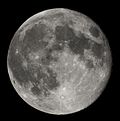
Orbit Lunar surface - Selenography
- Near side
- Far side
- Lunar mare
- (List)
- Craters
- (List)
- Mountains
- Valleys
- South Pole – Aitken basin
- Shackleton crater
- Water
- Soil
- Peak of eternal light
- Space weathering
- Transient lunar phenomenon
Lunar science Exploration Other topics - See also Solar System
- Natural satellite
Natural satellites of the Solar System Planetary satellites 
Other satellite systems Largest satellites - Inner satellites
- Trojans
- Irregulars
- List
- Timeline of discovery
- Naming
The Solar System  Categories:
Categories:- Moon
- Moons
Wikimedia Foundation. 2010.

